Can Increased Density Compensate for Extremely Late-Sown Wheat Yield?
Abstract
1. Introduction
2. Materials and Methods
2.1. Overview of Experimental Site
2.2. Method
2.2.1. Experimental Design
2.2.2. Yield and Yield Composition Factors
2.2.3. Dynamics of the Seedling Emergence Rate, Total Stem Number, and Panicle Number
2.2.4. Overwintering Morphology and Cell Osmotic Regulatory Substances
2.2.5. Number of Spikelets and Flowers
2.2.6. Small Panicle Base and Small Flower Base
primordia/late stage small flower primordia formation base
2.2.7. Grain-Filling Characteristics
2.2.8. Canopy Temperature
2.2.9. Data Analysis
3. Results and Analysis
3.1. Influence of Sowing Time and Density on Yield and Yield Components
3.2. Influence of Sowing Date and Planting Density on Panicle Number
3.2.1. Effects of Sowing Date and Planting Density on Panicle Number
3.2.2. Influence of Sowing Time and Density on Seedling Emergence Rate
3.2.3. Effects of Sowing Time on Morphology of Overwintering Plants and Levels of Cell Osmotic Regulatory Substances
3.3. Effects of Sowing Date and Density on Number of Grains per Spike
3.3.1. Effects of Sowing Date and Density on Number of Spikelets and Flowers
3.3.2. Effects of Sowing Date and Density on Original Number of Spikelets
3.3.3. Effects of Sowing Time and Density on Number of Small Flower Primordia Plants
3.3.4. Effects of Sowing Time and Density on Rate of Small Flower Primordia Formation
3.4. Influence of Sowing Time and Density on 1000-Grain Weights
3.4.1. Logistic Model for Grain-Filling
3.4.2. Crown Temperature and Humidity During Grain-Filling Process
3.4.3. Differences in 1000-Grain Weights
4. Discussion
4.1. Increasing Density Increased the Number of Main Stem Spikes in Extremely Late-Sown Wheat, Thus Increasing the Number of Harvested Spikes
4.2. Delayed Sowing Affected Young Spike Differentiation in Limited Late-Sown Wheat, Thus Reducing the Number of Grains per Spike
4.3. Extremely Late Wheat Grouting Was Limited by the Canopy Environment of the Population, Which in Turn Reduced the Thousand-Kernel Weight
5. Conclusions
Author Contributions
Funding
Data Availability Statement
Acknowledgments
Conflicts of Interest
References
- Dong, J.; Lu, H.; Wang, Y.; Ye, T.; Yuan, W. Estimating winter wheat yield based on a light use efficiency model and wheat variety data. ISPRS J. Photogramm. 2020, 160, 18–32. [Google Scholar] [CrossRef]
- Meng, L.; Liu, Z.; Zhang, L.; Hu, G.; Song, X. Cytological characterization of a thermo-sensitive cytoplasmic male-sterile wheat line having K-type cytoplasm of Aegilops kotschyi. Breed. Sci. 2016, 66, 752–761. [Google Scholar] [CrossRef] [PubMed]
- The Food and Agriculture Organization (FAO). FAO Statistics Database. 2020. Available online: https://www.fao.org/faostat/zh/#data/QCL (accessed on 23 January 2025).
- Zhao, G. Research on wheat planting regionalization in China (II). J. Triticeae Crop. 2020, 30, 1140–1147. [Google Scholar]
- Li, J.; Nie, S.; Niu, K.; Zhao, F.; Liu, M.; Zhang, J. Green, high-yield and efficient cultivation techniques for winter wheat under drip irrigation in the Ta’e Basin. China Agric. Technol. Ext. 2022, 38, 34–36. [Google Scholar]
- Wang, B.; Zhang, Y.; Hao, B.; Xu, X.; Zhao, Z.; Wang, Z.; Xue, Q. Grain yield and water use efficiency in extremely-late sown winter wheat cultivars under two irrigation regimes in the North China Plain. PLoS ONE 2016, 11, e0153695. [Google Scholar] [CrossRef]
- Dong, Y.; Wei, B.; Wang, L.; Zhang, Y.; Zhang, H.; Zhang, Y. Performance of winter-seeded spring wheat in Inner Mongolia. Agronomy 2019, 9, 507. [Google Scholar] [CrossRef]
- Dreccer, M.F.; Chapman, S.C.; Rattey, A.R.; Neal, J.; Song, Y.; Christopher, J.T.; Reynolds, M. Developmental and growth controls of tillering and water-soluble carbohydrate accumulation in contrasting wheat (Triticum aestivum L.) genotypes: Can we dissect them? J. Exp. Bot. 2013, 64, 143–160. [Google Scholar] [CrossRef]
- Akhtar, M.; Iqbal, R.M.; Jamil, M.; Akhtar, L.H. Effect of sowing date on emergence, tillering and grain yield of different wheat varieties under Bahawalpur conditions. Pak. J. Agric. Sci. 2012, 49, 255–259. [Google Scholar]
- Shah, F.; Coulter, J.A.; Ye, C.; Wu, W. Yield penalty due to delayed sowing of winter wheat and the mitigatory role of increased seeding rate. Eur. J. Agron. 2020, 119, 126120. [Google Scholar] [CrossRef]
- Li, C.; Li, W.; Luo, Y.; Jin, M.; Chang, Y.; Cui, H.; Sun, S.; Li, Y.; Wang, Z. Mixed cropping increases grain yield and lodging resistance by improving the canopy light environment of wheat populations. Eur. J. Agron. 2023, 147, 126849. [Google Scholar] [CrossRef]
- Zhang, F.; Zhang, D.; Li, L.; Zhang, Z.; Liang, X.; Wen, Q.; Chen, G.; Wu, Q.; Zhai, Y. Effect of planting density on canopy structure, microenvironment, and yields of uniformly sown winter wheat. Agronomy 2023, 13, 870. [Google Scholar] [CrossRef]
- Ma, S.; Wang, T.; Guan, X.; Zhang, X. Effect of sowing time and seeding rate on yield components and water use efficiency of winter wheat by regulating the growth redundancy and physiological traits of root and shoot. Field Crop Res. 2018, 221, 166–174. [Google Scholar] [CrossRef]
- Gao, Y.; Zhang, M.; Yao, C.; Liu, Y.; Wang, Z.; Zhang, Y. Increasing seeding density under limited irrigation improves crop yield and water productivity of winter wheat by constructing a reasonable population architecture. Agric. Water Manag. 2021, 253, 106951. [Google Scholar] [CrossRef]
- Mu, H.; Wang, Z.; Sun, L.; Huang, Y.; Song, Y.; Zhang, R.; Wu, Z.; Fu, K.; Duan, J.; Kang, G. Optimizing nitrogen fertilization and planting density management enhances lodging resistance and wheat yield by promoting carbohydrate accumulation and single spike development. Crop Sci. 2024, 64, 3461–3479. [Google Scholar] [CrossRef]
- Lollato, R.P.; Ruiz Diaz, D.A.; DeWolf, E.; Knapp, M.; Peterson, D.E.; Fritz, A.K. Agronomic practices for reducing wheat yield gaps: A quantitative appraisal of progressive producers. Crop Sci. 2019, 59, 333–350. [Google Scholar] [CrossRef]
- Zheng, F.; Chu, J.; Guo, X.; Zhang, X.; Ma, J.; He, M.; Dai, X. Combining wide seedling strip planting with a higher plant density results in greater yield gains in winter wheat. Ann. Agric. Sci. 2024, 69, 1–10. [Google Scholar] [CrossRef]
- Chen, M.; Zhu, Y.; Ren, M.; Jiang, L.; He, J.; Dong, R. Does belt uniform sowing improve winter wheat yield under high sowing density? Agronomy 2022, 12, 2936. [Google Scholar] [CrossRef]
- Coventry, D.R.; Reeves, T.G.; Brooke, H.D.; Cann, D.K. Influence of genotype, sowing date, and seeding rate on wheat development and yield. Aust. J. Exp. Agric. 1993, 33, 751–757. [Google Scholar] [CrossRef]
- Yin, L.; Dai, X.; He, M. Delayed sowing improves nitrogen utilization efficiency in winter wheat without impacting yield. Field Crop Res. 2018, 221, 90–97. [Google Scholar] [CrossRef]
- Sun, H.; Shao, L.; Chen, S.; Wang, Y.; Zhang, X. Effects of sowing time and rate on crop growth and radiation use efficiency of winter wheat in the North China Plain. Int. J. Plant Prod. 2013, 7, 117–138. [Google Scholar]
- Bastos, L.M.; Carciochi, W.; Lollato, R.P.; Jaenisch, B.R.; Rezende, C.R.; Schwalbert, R.; Vara Prasad, P.V.; Zhang, G.; Fritz, A.K.; Foster, C. Winter wheat yield response to plant density as a function of yield environment and tillering potential: A review and field studies. Front. Plant Sci. 2020, 11, 54. [Google Scholar] [CrossRef] [PubMed]
- Yao, F.; Li, Q.; Zeng, R.; Shi, S. Effects of different agricultural treatments on narrowing winter wheat yield gap and nitrogen use efficiency in China. J. Integr. Agric. 2021, 20, 383–394. [Google Scholar] [CrossRef]
- Li, F. Preliminary study on the superiority of spring wheat winter sowing and field techniques. Chin. Agicr. Sci. 1961, 2, 20. [Google Scholar]
- Tulufan County Agricultural Science Institute. Investigation report on the cultivation of egg-wrapped wheat in the First Management Area of Wuxing Commune in Tulufan County. Agric. Sci. 1961, 207–210. [Google Scholar]
- Irigoyen, J.J.; Einerich, D.W.; Sánchez-Díaz, M. Water stress induced changes in concentrations of proline and total soluble sugars in nodulated alfalfa (Medicago sativd) plants. Physiol. Plantarum. 1992, 84, 55–60. [Google Scholar] [CrossRef]
- Aula, L.; Easterly, A.C.; Creech, C.F. Winter wheat seeding decisions for improved grain yield and yield components. Agronomy 2022, 12, 3061. [Google Scholar] [CrossRef]
- Sattar, A.; Nanda, G.; Singh, G.; Jha, R.K.; Bal, S.K. Responses of phenology, yield attributes, and yield of wheat varieties under different sowing times in Indo-Gangetic Plains. Front. Plant Sci. 2023, 14, 1224334. [Google Scholar] [CrossRef]
- Zhu, Y.; Liu, J.; Li, J.; Xian, L.; Chu, J.; Liu, H.; Song, J.; Sun, Y.; Dai, Z. Delayed sowing increased dry matter accumulation during stem elongation in winter wheat by improving photosynthetic yield and nitrogen accumulation. Eur. J. Agron. 2023, 151, 127004. [Google Scholar] [CrossRef]
- Li, S.; Song, M.; Duan, J.; Yang, J.; Zhu, Y.; Zhou, S. Regulation of spraying 6-BA in the late jointing stage on the fertile floret development and grain setting in winter wheat. Agronomy 2019, 9, 546. [Google Scholar] [CrossRef]
- Zhang, Z.; Huang, J.; Gao, Y.; Liu, Y.; Li, J.; Zhou, X.; Yao, C.; Wang, Z.; Sun, Z.; Zhang, Y. Suppressed ABA signal transduction in the spike promotes sucrose use in the stem and reduces grain number in wheat under water stress. J. Exp. Bot. 2020, 71, 7241–7256. [Google Scholar] [CrossRef]
- Lin, F.; Li, C.; Xu, B.; Chen, J.; Chen, A.; Hassan, M.A.; Liu, B.; Xu, H.; Chen, X.; Sun, J. Late spring cold reduces grain number at various spike positions by regulating spike growth and assimilate distribution in winter wheat. Crop J. 2023, 11, 1272–1278. [Google Scholar] [CrossRef]
- Liu, J.; He, Q.; Zhou, G.; Song, Y.; Guan, Y.; Xiao, X.; Sun, W.; Shi, Y.; Zhou, K.; Zhou, S. Effects of sowing date variation on winter wheat yield: Conclusions for suitable sowing dates for high and stable yield. Agronomy 2023, 13, 991. [Google Scholar] [CrossRef]
- Zhou, J.; Zhang, Z.; Xin, Y.; Chen, G.; Wu, Q.; Liang, X.; Zhai, Y. Effects of planting density on root spatial and temporal distribution and yield of winter wheat. Agronomy 2022, 12, 3014. [Google Scholar] [CrossRef]
- Sun, Y.; Yang, W.; Wu, Y.; Cui, Y.; Dong, Y.; Dong, Z.; Hai, J. The effects of different sowing density and nitrogen topdressing on wheat were investigated under the cultivation mode of hole sowing. Agronomy 2023, 13, 1733. [Google Scholar] [CrossRef]
- Su, W.P.; Wang, H.; Aimulaguli, K.; Zhao, X.; Xue, L.; Zhang, J.; Liu, J.; Sun, S. Comparison of growth characteristics and yields of different wheat varieties planted in the approaching winter in northern Xinjiang. Crops 2021, 37, 108–114. [Google Scholar]
- Wang, Z.; Khan, S.; Sun, M.; Ren, A.; Lin, W.; Ding, P.; Noor, H.; Yu, S.; Feng, Y.; Wang, Q. Optimizing the wheat seeding rate for wide-space sowing to improve yield and water and nitrogen utilization. Int. J. Plant Prod. 2021, 15, 553–562. [Google Scholar] [CrossRef]
- Cai, D.; Shoukat, M.R.; Zheng, Y.; Tan, H.; Meng, F.; Yan, H. Optimizing center pivot irrigation to regulate field microclimate and wheat physiology under dry-hot wind conditions in the North China Plain. Water 2022, 14, 708. [Google Scholar] [CrossRef]
- Yang, J.; Feng, Y.; Chi, T.; Wen, Q.; Liang, P.; Wang, A.; Li, P. Mitigation of elevated CO2 concentration on warming-induced changes in wheat is limited under extreme temperature during the grain filling period. Agronomy 2023, 13, 1379. [Google Scholar] [CrossRef]
- Zhang, Z.; Xing, Z.; Zhou, N.; Zhao, C.; Liu, B.; Jia, D.; Wei, H.; Guo, B.; Zhang, H. Effects of post-anthesis temperature and radiation on grain filling and protein quality of wheat (Triticum aestivum L.). Agronomy 2022, 12, 2617. [Google Scholar] [CrossRef]
- Wang, T.; Li, L.; Wang, X.; Xue, L.; Zhang, X.; Sun, W.; Wang, H. Effect of snowing date on growth characteristic and yield and quality of spring wheat varieties sowing in winter. J. China Agric. Univ. 2021, 26, 28–40. [Google Scholar]

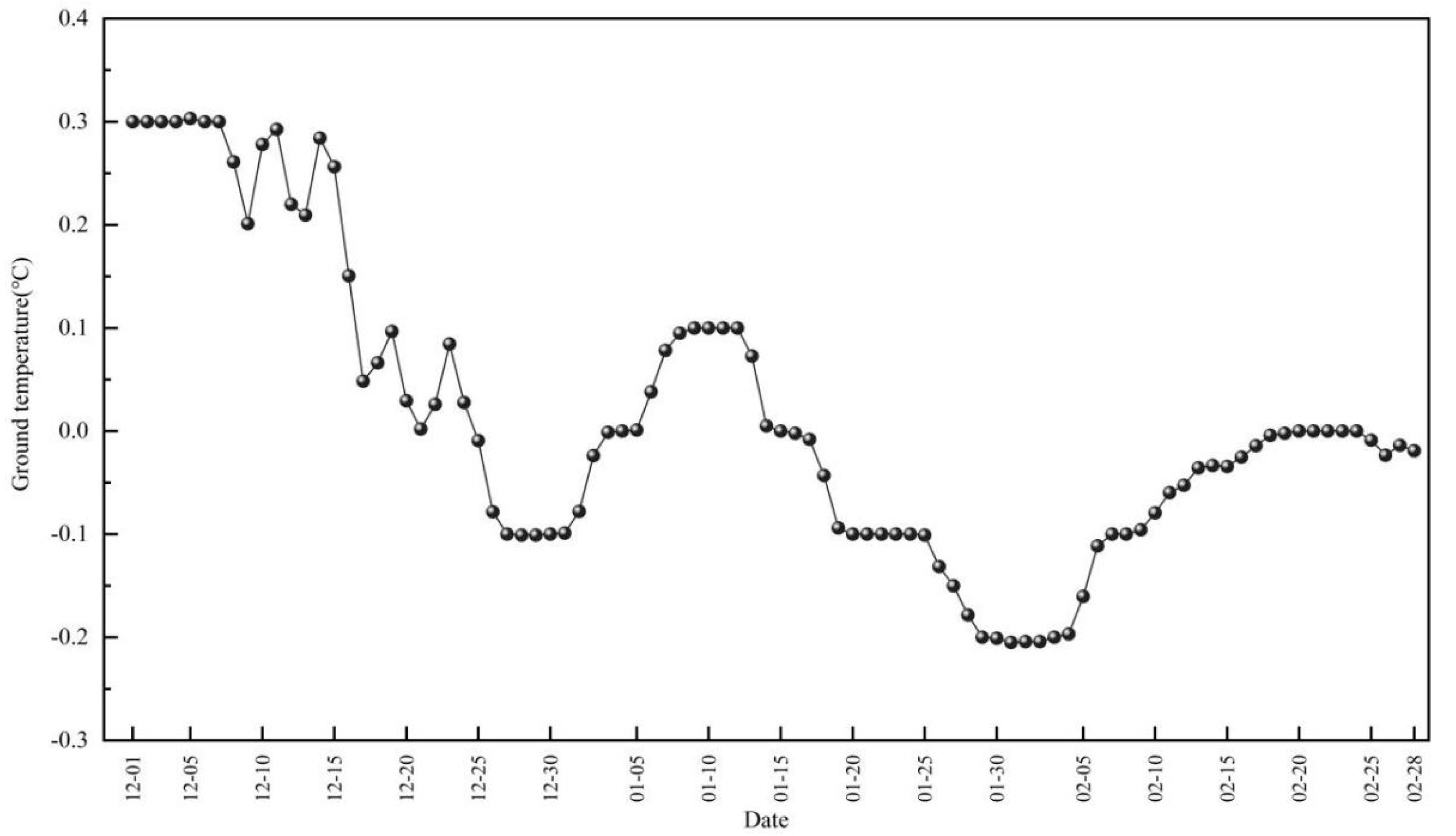
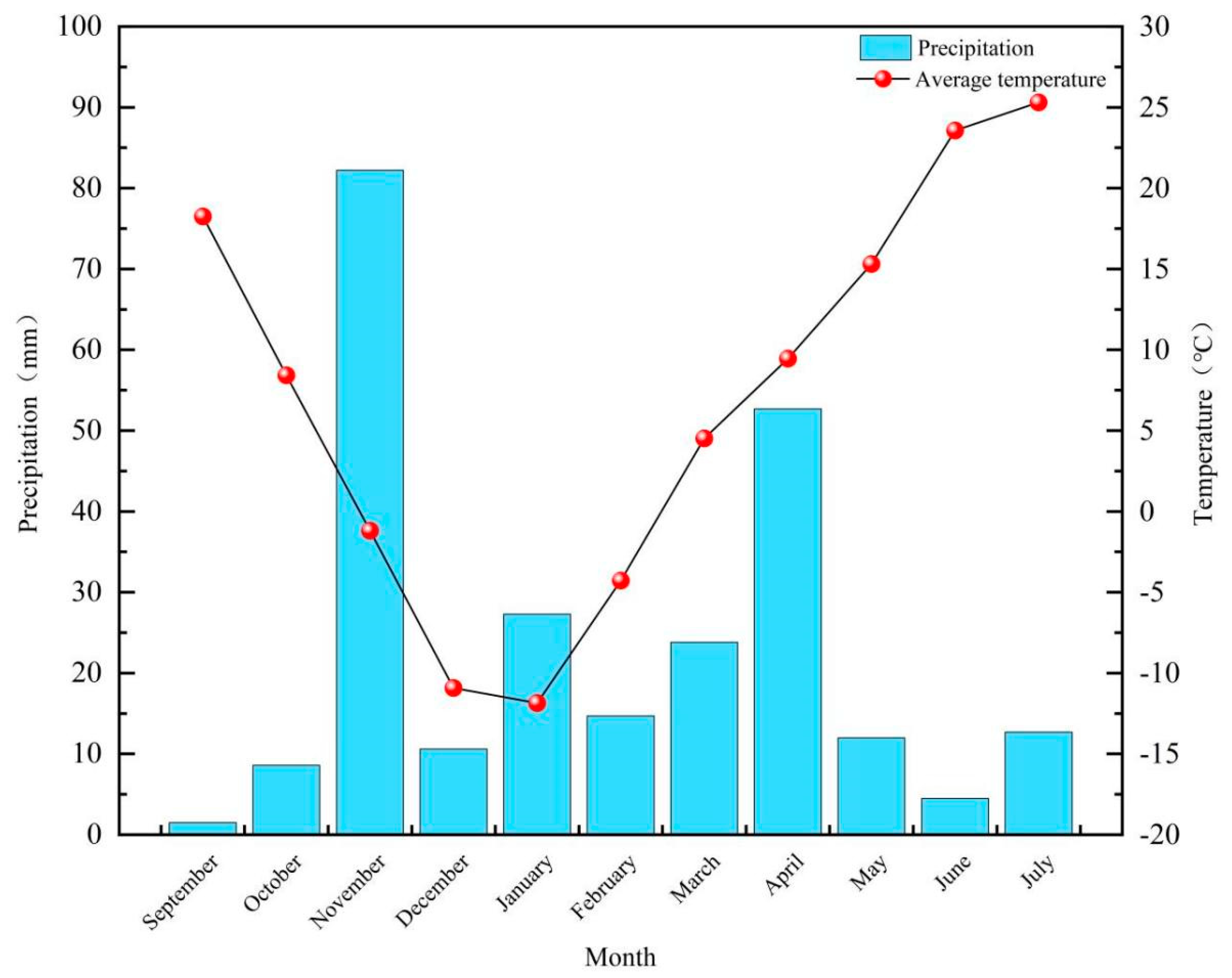
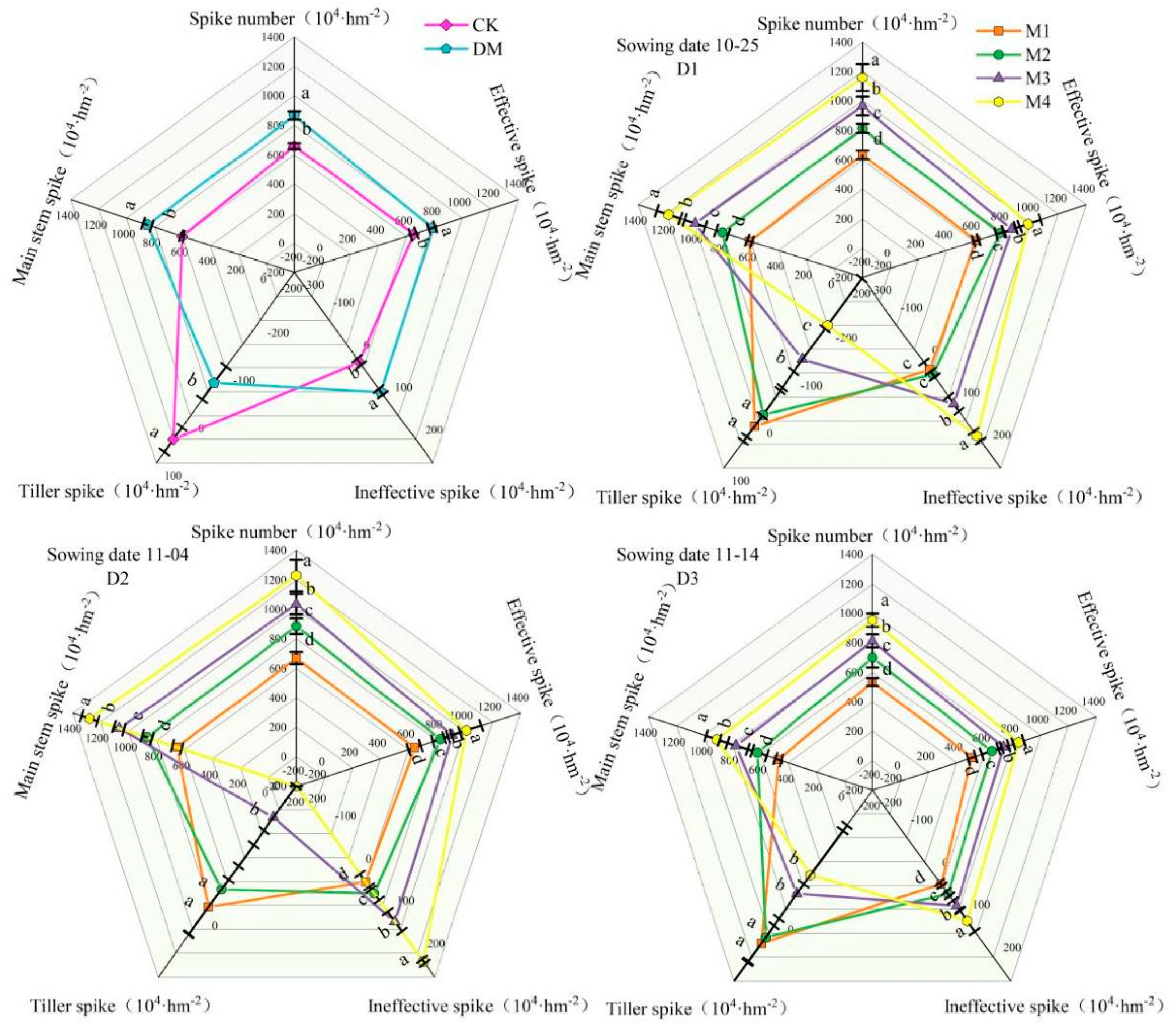

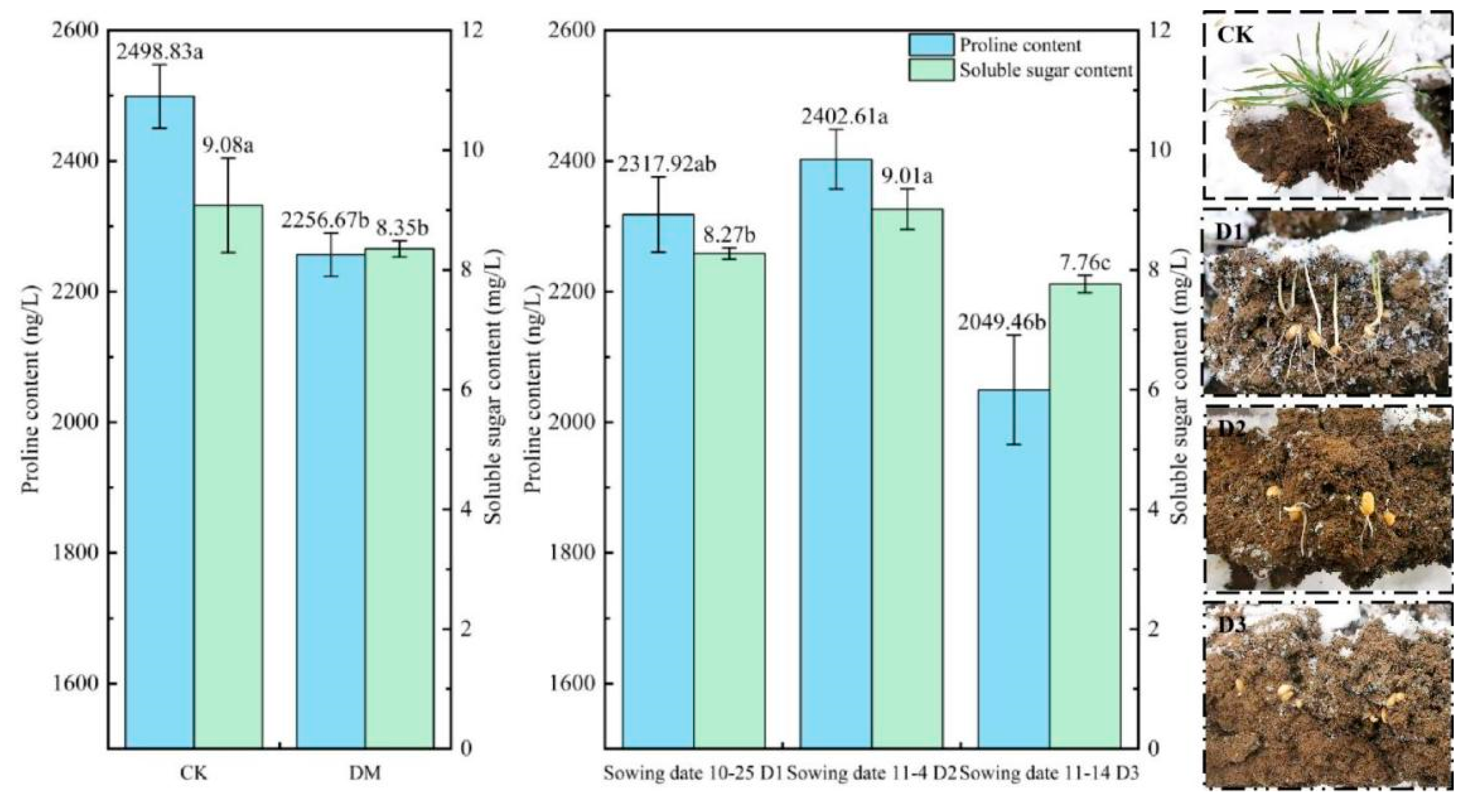

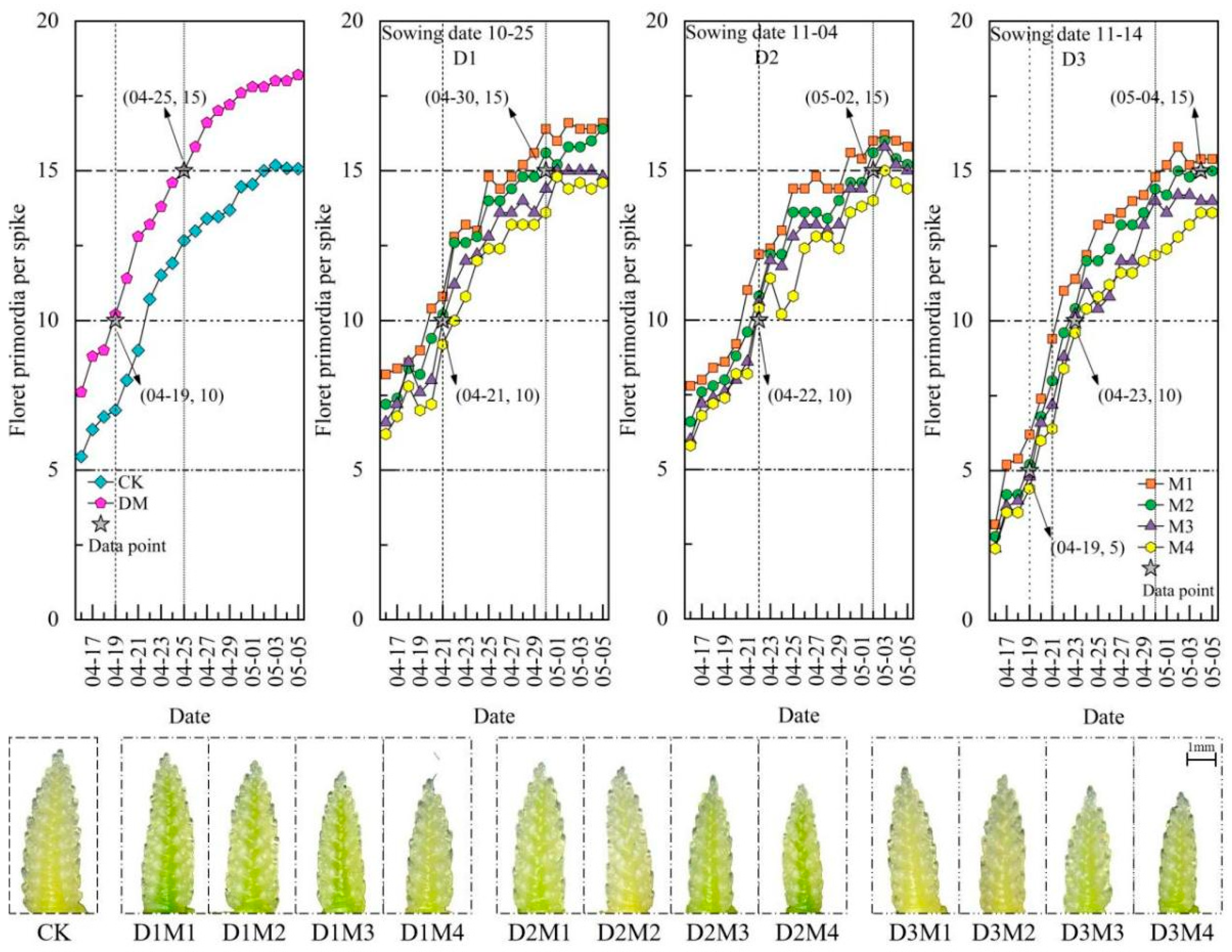
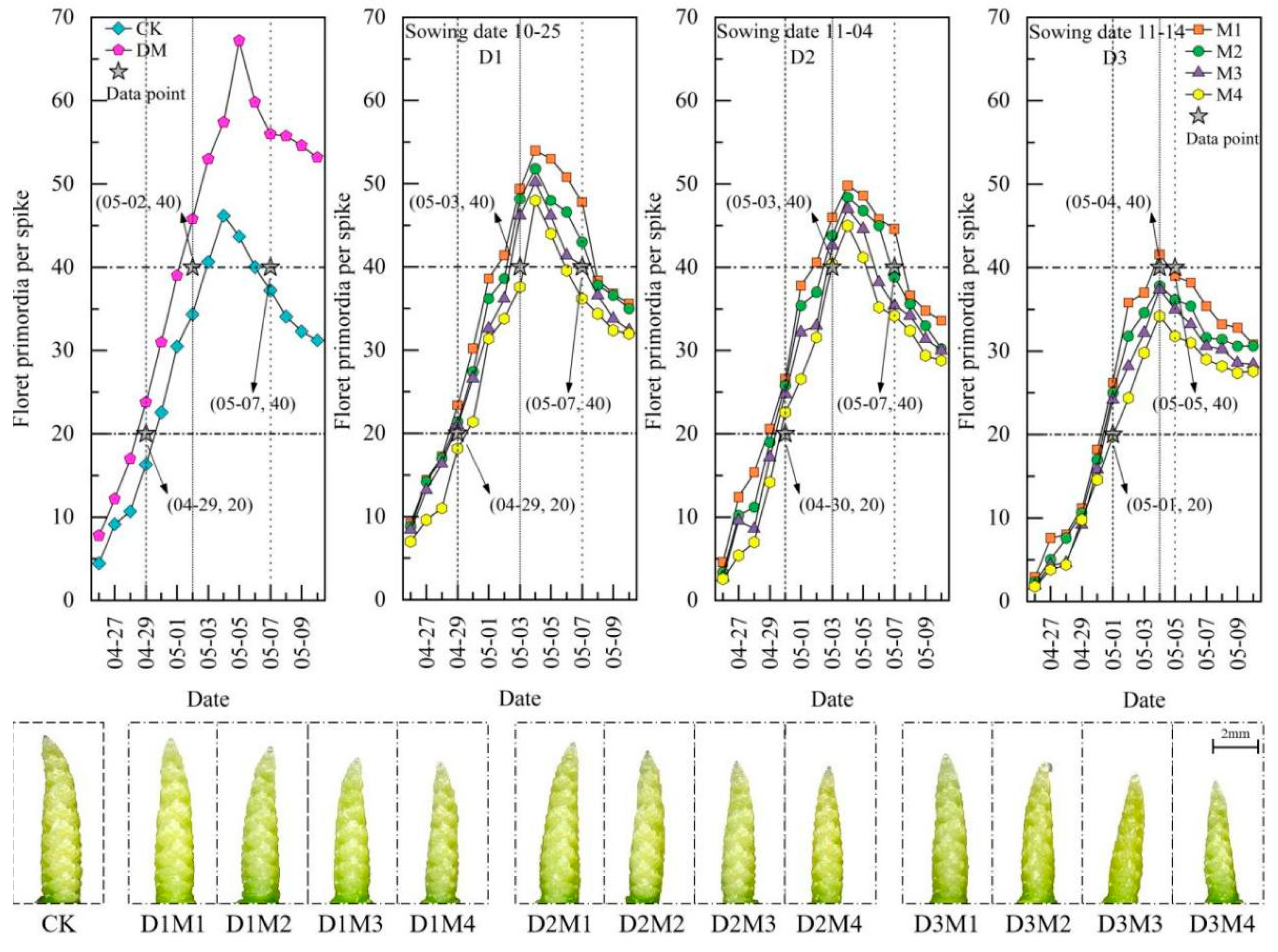


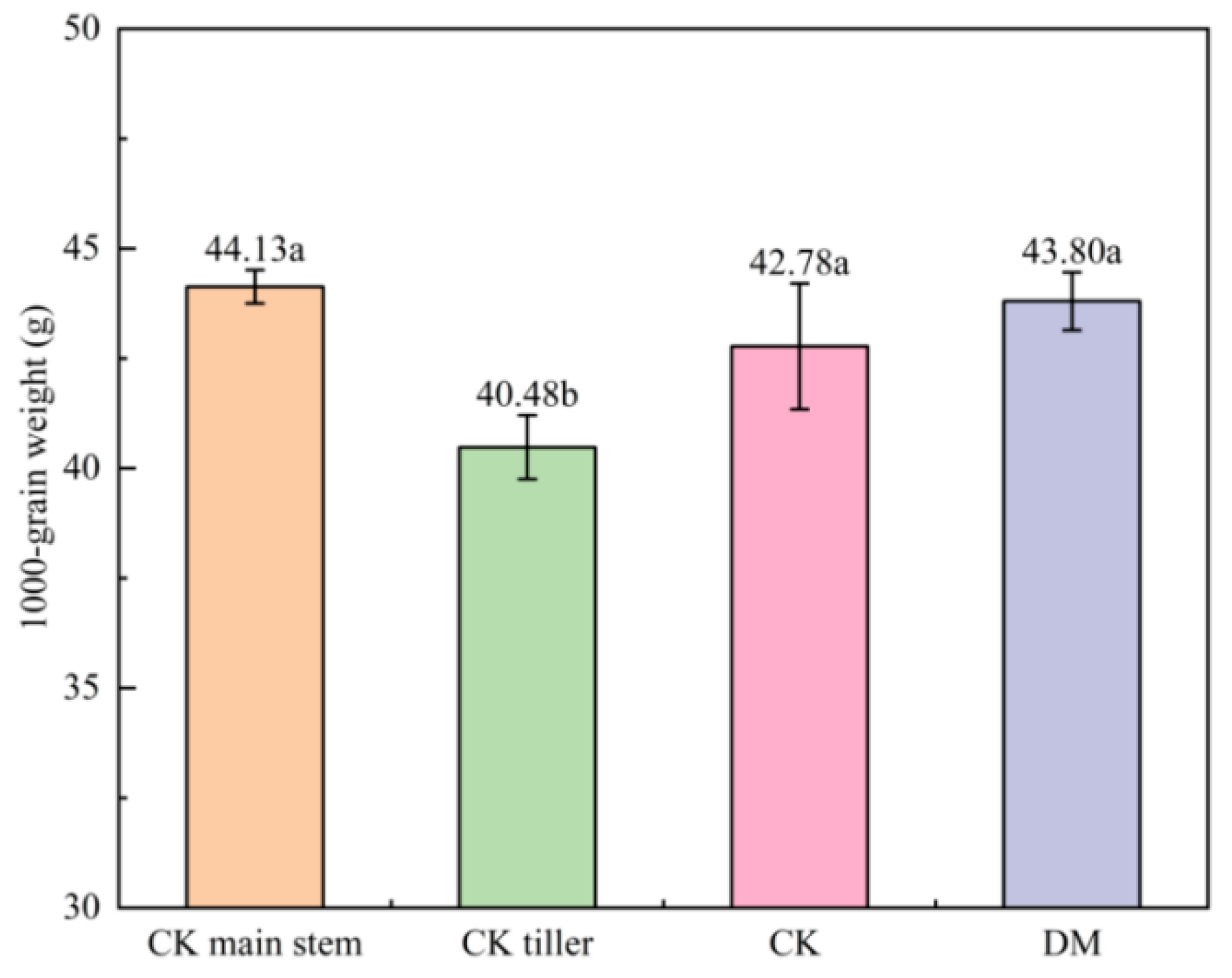
| Soil Layer (cm) | Organic Matter (g/kg) | Alkali Hydrolyzed Nitrogen (mg/kg) | Olsen-P (mg/kg) | Available K (mg/kg) | pH | Total Nitrogen (g/kg) | Total Phosphorus (g/kg) | Total Potassium (g/kg) |
|---|---|---|---|---|---|---|---|---|
| 0~20 | 25.19 | 45.50 | 15.76 | 164.90 | 8.32 | 0.34 | 1.14 | 14.84 |
| 20~40 | 22.09 | 45.00 | 23.60 | 208.00 | 8.25 | 0.26 | 0.80 | 14.62 |
| Sowing Date | Density | 2021–2022 | 2022–2023 | |||||||
|---|---|---|---|---|---|---|---|---|---|---|
| Spikelet/ (104·hm−2) | Grains per Spike | 1000-Grain Weight/g | Yield/ (kg·hm−2) | Spikelet/ (104·hm−2) | Grains per Spike | 1000-Grain Weight/g | Yield/ (kg·hm−2) | |||
| CK | 651.17 b | 50.53 a | 43.20 a | 9711.84 a | 649.88 b | 51.90 a | 42.78 a | 9733.79 a | ||
| DM | 785.74 a | 31.62 b | 43.63 a | 8936.44 b | 783.56 a | 31.81 b | 43.80 a | 8994.44 b | ||
| D1 (10–25) | M1 | 611.50 d | 40.60 a | 44.94 a | 9198.06 a | 616.75 h | 42.75 a | 44.92 ab | 9344.42 ab | |
| M2 | 783.50 c | 33.80 b | 44.53 a | 9290.33 a | 785.25 e | 34.05 cd | 44.68 bc | 9383.53 ab | ||
| M3 | 861.50 b | 28.13 c | 42.60 b | 8943.46 ab | 866.75 c | 27.20 ef | 43.00 fg | 9041.31 bcd | ||
| M4 | 984.67 a | 23.47 c | 41.89 b | 8486.63 b | 983.63 a | 23.50 f | 42.50 g | 8756.85 cde | ||
| Average | 810.29 b | 31.50 ab | 43.49 b | 8979.62 b | 813.09 b | 31.88 ab | 43.77 b | 9131.53 a | ||
| D2 (11–04) | M1 | 651.83 d | 39.07 a | 44.33 a | 9426.29 ab | 642.63 gh | 38.65 ab | 44.45 bcd | 9380.47 ab | |
| M2 | 835.50 c | 31.33 b | 43.98 a | 9618.30 a | 829.75 d | 32.05 cd | 43.70 def | 9625.14 a | ||
| M3 | 916.67 b | 26.27 bc | 42.74 b | 9218.53 ab | 914.50 b | 26.65 ef | 43.09 efg | 9199.58 abc | ||
| M4 | 1036.00 a | 23.27 c | 42.64 b | 8880.26 b | 1016.50 a | 22.80 f | 42.64 g | 9022.70 bcd | ||
| Average | 860.00 a | 29.98 b | 43.42 b | 9285.84 a | 850.84 a | 30.04 b | 43.47 b | 9306.97 a | ||
| D3 (11–14) | M1 | 508.33 d | 41.73 a | 45.35 a | 8180.03 a | 512.13 i | 41.70 a | 45.58 a | 8230.08 f | |
| M2 | 661.83 c | 35.93 b | 44.75 a | 8504.54 a | 654.13 g | 36.05 bc | 44.50 bcd | 8451.56 ef | ||
| M3 | 735.00 b | 29.87 c | 43.83 b | 8711.32 a | 737.25 f | 30.20 de | 43.90 cde | 8811.16 cde | ||
| M4 | 842.50 a | 25.93 c | 42.00 c | 8779.48 a | 843.50 cd | 26.10 ef | 42.69 g | 8686.51 def | ||
| Average | 686.92 c | 33.37 a | 43.98 a | 8543.84 c | 686.75 c | 33.51 a | 44.17 a | 8544.83 b | ||
| F | D | 138.30 ** | 5.79 ** | 3.90 * | 15.05 ** | 198.41 ** | 5.79 ** | 4.09 ** | 21.75 ** | |
| M | 304.28 ** | 75.48 ** | 48.48 ** | 2.43 ns | 457.63 ** | 78.27 ** | 6.34 ** | 1.90 ns | ||
| D×M | 0.55 ns | 0.50 ns | 2.32 * | 2.87 ns | 0.94 ns | 0.50 ns | 42.71 ** | 2.78 ns | ||
| Sowing Date | Density | Equation | K | a | b | R2 |
|---|---|---|---|---|---|---|
| CK | y = 54.5758/(1 + e2.8275−0.1888t) | 54.5758 | 2.8275 | −0.1888 | RR = 0.9980 | |
| DM | y = 52.9909/(1 + e2.8449−0.1893t) | 52.9909 | 2.8449 | −0.1893 | RR = 0.9987 | |
| D1 (10–25) | M1 | y = 55.8181/(1 + e2.7648−0.1835t) | 55.8181 | 2.7648 | −0.1835 | RR = 0.9971 |
| M2 | y = 53.3995/(1 + e2.7838−0.1884t) | 53.3995 | 2.7838 | −0.1884 | RR = 0.9985 | |
| M3 | y = 51.2446/(1 + e2.8189−0.1915t) | 51.2446 | 2.8189 | −0.1915 | RR = 0.9983 | |
| M4 | y = 48.7770/(1 + e2.8527−0.1967t) | 48.7770 | 2.8527 | −0.1967 | RR = 0.9994 | |
| Average | y = 52.3098/(1 + e2.8051−0.1900t) | 52.3098 | 2.8051 | −0.1900 | RR = 0.9983 | |
| D2 (11–04) | M1 | y = 53.7074/(1 + e2.8162−0.1907t) | 53.7074 | 2.8162 | −0.1907 | RR = 0.9992 |
| M2 | y = 52.5196/(1 + e2.8424−0.1925t) | 52.5196 | 2.8424 | −0.1925 | RR = 0.9982 | |
| M3 | y = 52.0463/(1 + e2.8000−0.1872t) | 52.0463 | 2.8000 | −0.1872 | RR = 0.9984 | |
| M4 | y = 49.9992/(1 + e2.7614−0.1856t) | 49.9992 | 2.7614 | −0.1856 | RR = 0.9979 | |
| Average | y = 52.0681/(1 + e2.8050−−0.1890t) | 52.0681 | 2.8050 | −0.1890 | RR = 0.9984 | |
| D3 (11–14) | M1 | y = 55.7547/(1 + e2.9285−0.1932t) | 55.7547 | 2.9285 | −0.1932 | RR = 0.9984 |
| M2 | y = 55.3836/(1 + e2.9299−0.1915t) | 55.3836 | 2.9103 | −0.1915 | RR = 0.9987 | |
| M3 | y = 54.4009/(1 + e2.8577−0.1835t) | 54.4009 | 2.8577 | −0.1835 | RR = 0.9975 | |
| M4 | y = 53.1286/(1 + e2.9646−0.1877t) | 53.1286 | 2.9642 | −0.1877 | RR = 0.9988 | |
| Average | y = 54.6670/(1 + e2.9107−−0.1890t) | 54.6670 | 2.9107 | −0.1890 | RR = 0.9970 | |
| Sowing Date | Density | t1/(d) | t2/(d) | t3/(d) | Tmax/(d) | Vmax/(g∙d−1) | Vmean/(g∙d−1) | T1 | T2 | T3 |
|---|---|---|---|---|---|---|---|---|---|---|
| CK | 1.4701 | 12.4806 | 29.8438 | 2.5760 | 14.9762 | 1.8287 | 1.4701 | 11.0105 | 17.3632 | |
| DM | 1.4338 | 12.4800 | 29.7974 | 2.5078 | 15.0285 | 1.7784 | 1.4338 | 11.0463 | 17.3174 | |
| D1 (10–25) | M1 | 1.6347 | 12.7189 | 30.5836 | 2.5607 | 15.0670 | 1.8251 | 1.6347 | 11.0841 | 17.8647 |
| M2 | 1.5559 | 12.4244 | 29.8245 | 2.5151 | 14.7760 | 1.7905 | 1.5559 | 10.8685 | 17.4001 | |
| M3 | 1.4653 | 12.2887 | 29.4071 | 2.4533 | 14.7201 | 1.7426 | 1.4653 | 10.8235 | 17.1184 | |
| M4 | 1.3659 | 12.0245 | 28.6903 | 2.3986 | 14.5028 | 1.7001 | 1.3659 | 10.6585 | 16.6659 | |
| Average | 1.5055 | 12.3641 | 29.6264 | 2.4819 | 14.7665 | 1.7646 | 1.5055 | 10.8587 | 17.2623 | |
| D2 (11–04) | M1 | 1.4764 | 12.3353 | 29.5255 | 2.5605 | 14.7677 | 1.8190 | 1.4764 | 10.8588 | 17.1902 |
| M2 | 1.4145 | 12.2680 | 29.2975 | 2.5275 | 14.7657 | 1.7926 | 1.4145 | 10.8535 | 17.0295 | |
| M3 | 1.5349 | 12.5351 | 30.0467 | 2.4358 | 14.9573 | 1.7322 | 1.5349 | 11.0002 | 17.5116 | |
| M4 | 1.6229 | 12.5683 | 30.2309 | 2.3200 | 14.8782 | 1.6539 | 1.6229 | 10.9455 | 17.6626 | |
| Average | 1.5122 | 12.4267 | 29.7751 | 2.4609 | 14.8422 | 1.7494 | 1.5122 | 10.9145 | 17.3485 | |
| D3 (11–14) | M1 | 1.2549 | 12.3780 | 29.3458 | 2.6930 | 15.1579 | 1.8999 | 1.2549 | 11.1231 | 16.9678 |
| M2 | 1.2986 | 12.4554 | 29.5738 | 2.6515 | 15.1974 | 1.8727 | 1.1877 | 11.1567 | 17.1184 | |
| M3 | 1.4546 | 12.8990 | 30.7637 | 2.4956 | 15.5733 | 1.7683 | 1.5045 | 11.4443 | 17.8647 | |
| M4 | 1.2272 | 12.8053 | 30.2703 | 2.4931 | 15.7922 | 1.7551 | 1.1120 | 11.5781 | 17.4650 | |
| Average | 1.3088 | 12.6344 | 29.9884 | 2.5833 | 15.4302 | 1.8240 | 1.2648 | 11.3256 | 17.3540 | |
Disclaimer/Publisher’s Note: The statements, opinions and data contained in all publications are solely those of the individual author(s) and contributor(s) and not of MDPI and/or the editor(s). MDPI and/or the editor(s) disclaim responsibility for any injury to people or property resulting from any ideas, methods, instructions or products referred to in the content. |
© 2025 by the authors. Licensee MDPI, Basel, Switzerland. This article is an open access article distributed under the terms and conditions of the Creative Commons Attribution (CC BY) license (https://creativecommons.org/licenses/by/4.0/).
Share and Cite
Tian, W.; Chen, G.; Zhang, Q.; Zhang, Z.; Zhang, J.; Yu, S.; Shi, S.; Zhang, J. Can Increased Density Compensate for Extremely Late-Sown Wheat Yield? Agronomy 2025, 15, 607. https://doi.org/10.3390/agronomy15030607
Tian W, Chen G, Zhang Q, Zhang Z, Zhang J, Yu S, Shi S, Zhang J. Can Increased Density Compensate for Extremely Late-Sown Wheat Yield? Agronomy. 2025; 15(3):607. https://doi.org/10.3390/agronomy15030607
Chicago/Turabian StyleTian, Wenqiang, Guangzhou Chen, Qiangbin Zhang, Zhilin Zhang, Jun Zhang, Shan Yu, Shubing Shi, and Jinshan Zhang. 2025. "Can Increased Density Compensate for Extremely Late-Sown Wheat Yield?" Agronomy 15, no. 3: 607. https://doi.org/10.3390/agronomy15030607
APA StyleTian, W., Chen, G., Zhang, Q., Zhang, Z., Zhang, J., Yu, S., Shi, S., & Zhang, J. (2025). Can Increased Density Compensate for Extremely Late-Sown Wheat Yield? Agronomy, 15(3), 607. https://doi.org/10.3390/agronomy15030607






